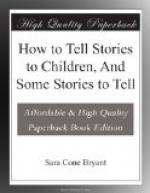Having this essential body of the story in mind, one then decides which of the steps toward the climax are needed for safe arrival there, and keeps these. When two or more steps can be covered in a single stride, one makes the stride. When a necessary explanation is unduly long, or is woven into the story in too many strands, one disposes of it in an introductory statement, or perhaps in a side remark. If there are two or more threads of narrative, one chooses among them, and holds strictly to the one chosen, eliminating details which concern the others.
In order to hold the simplicity of plot so attained, it is also desirable to have but few personages in the story, and to narrate the action from the point of view of one of them,—usually the hero. To shift the point of view of the action is confusing to the child’s mind.
When the analysis and condensation have been accomplished, the whole must be cast in simple language, keeping if possible the same kind of speech as that used in the original, but changing difficult or technical terms to plain, and complex images to simple and familiar ones.
All types of adaptation share in this need of simple language,—stories which are too short, as well as those which are too long, have this feature in their changed form. The change in a short story is applied oftenest where it becomes desirable to amplify a single anecdote, or perhaps a fable, which is told in very condensed form. Such an instance is the following anecdote of heroism, which in the original is quoted in one of F.W. Robertson’s lectures on Poetry.
A detachment of troops was marching along a valley, the cliffs overhanging which were crested by the enemy. A sergeant, with eleven men, chanced to become separated from the rest by taking the wrong side of a ravine, which they expected soon to terminate, but which suddenly deepened into an impassable chasm. The officer in command signalled to the party an order to return. They mistook the signal for a command to charge; the brave fellows answered with a cheer, and charged. At the summit of the steep mountain was a triangular platform, defended by a breastwork, behind which were seventy of the foe. On they went, charging up one of those fearful paths, eleven against seventy. The contest could not long be doubtful with such odds. One after another they fell; six upon the spot, the remainder hurled backwards; but not until they had slain nearly twice their own number.
There is a custom, we are told, amongst the hillsmen, that when a great chieftain of their own falls in battle, his wrist is bound with a thread either of red or green, the red denoting the highest rank. According to custom, they stripped the dead, and threw their bodies over the precipice. When their comrades came, they found their corpses stark and gashed; but round both wrists of every British hero was twined the red thread!
This anecdote serves its purpose of illustration perfectly well, but considered as a separate story it is somewhat too explanatory in diction, and too condensed in form. Just as the long story is analysed for reduction of given details, so this must be analysed,—to find the details implied. We have to read into it again all that has been left between the lines.




